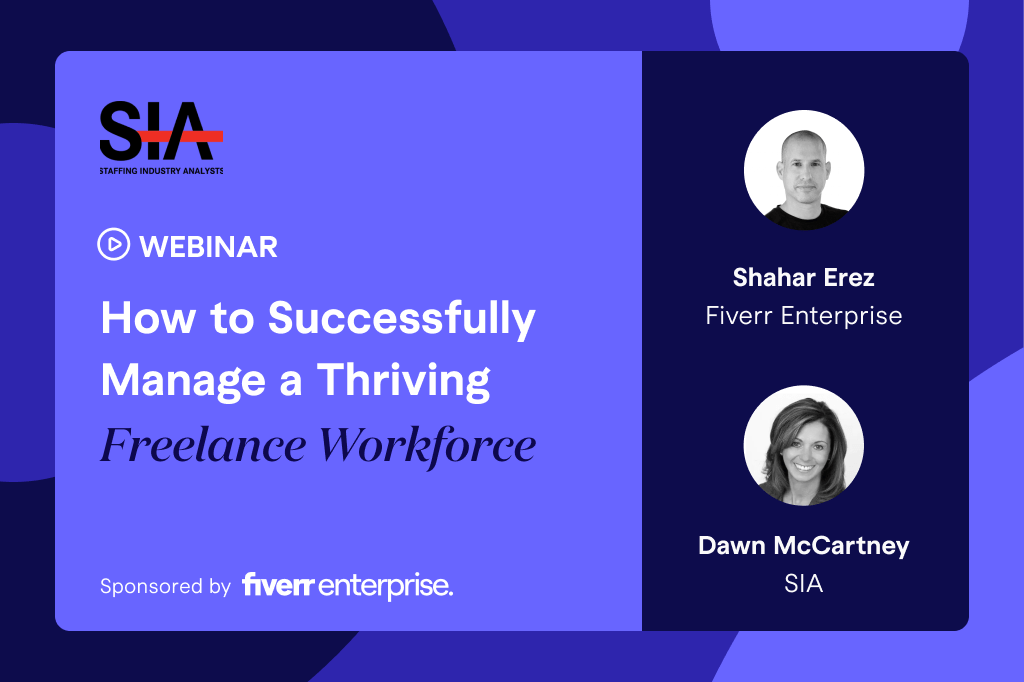Our recent webinar with Staffing Industry Analysts (SIA) was a deep dive into how enterprises can manage a growing workforce effectively. Shahar Erez from Fiverr Enterprise was joined by Dawn McCartney from SIA to discuss how today, the alternative workforce has become truly mainstream. As a result, the segment of the workforce that includes contractors, temp workers, freelancers, and gig employment needs to be part of an organizational strategy.
With so much on the line, how can technology best support businesses with everything from sourcing and hiring freelancers, to ongoing scheduling, onboarding, compliance and payments?
You can watch the webinar here, and keep reading for your highlights!
The Future of Work is Flexible
According to a survey of ours, 33% of the workforce wants to be their own boss, and are looking for autonomy in the way they work. In addition, 72% of the workforce demand workplace flexibility, showing that even if they don’t want to freelance, they need greater control over their hours, their place of work, and the tasks they complete.
Looking to the future, 45% of high-schoolers say they will never take a steady job. Even if we allow for Gen Z hubris, it’s important to pay attention to the way the workforce is changing. It’s time to consider how you are going to attract and retain a workforce for whom flexibility is their #1 perk, especially as skills gaps grow.
A Talent Cloud Allows Companies to Access Expertise Quickly
And hey, the benefits aren’t just for the workers! There are many great reasons why an organization might use a talent cloud approach, in contrast to relying on full-time employees alone. 65% of organizations say a talent cloud is a productive way of updating their skills to remain relevant, compared with just 45% when considering full-time employees. 66% of organizations say freelancers increase their speed to market, and 64% say this strategy boosts their organizational agility.
It’s clear that a contingent workforce strategy is about a lot more than cost cutting. The main reason to hire freelancers is to create a DNA within the company of being able to expand and contract with ease to fill project and skills gaps. With freelancers, your organization can gain agility, and can hit the market sooner with new products, services, and feature releases. That’s why companies without freelancers are falling behind in terms of their ability to execute at speed.
Organizations are Recognizing their Tech Gaps
With such an emergent need, it’s not surprising to see that many businesses are looking to technology to support a contingent workforce strategy. SIA found that 55% are already using analytics and benchmarking tools for talent acquisition, with a further 30% considering this technology for their business within 24 months.
In addition, 28% of companies have onboarded a full talent platform, where hiring managers can connect with freelancers to handle work arrangements, often from end-to-end. 41% are considering buying a digital platform within the next two years. If this technology isn’t already on your radar, you’re being left behind.
Sidestepping Friction with the Right Technology
For many organizations, it’s clear that freelancers are the answer, but that awareness doesn’t necessarily translate to an easy adoption of a contingent workforce. Many hurdles stand in the way, from compliance and legal constraints, to legacy systems, or practically finding top talent in the first place.
Organizations in this position should take some time to consider what a new process could look like, eliminating redundant steps, and adopting a new agile system to manage freelancers from end-to-end.
While there may be challenges such as getting Legal on side, when you can show key stakeholders the benefits of a process that can be digitized, enforcing documentation and signatures as part of the workflow for example, this can help get them on board, recognizing that automation is actually reducing risk. This can go a long way towards getting them excited about the idea! The same is true for IT, Finance, HR, and any other team — your digital transformation should make them confident and happy that their job is going to be made easier.
Tips for Success When Onboarding a Digital Freelance Management Solution
Once you have the right technology in place, everything should run like clockwork, but it can take some work to get the transition started. Start with just one business unit, and make sure to get all your data together ahead of time, including how many freelancers you currently work with and across which teams. Relying on one standalone solution can dramatically reduce complexity, so it’s important to shop around to make sure your choice checks all the boxes for your business context.
At Fiverr Enterprise, SMEs can be up and running with our freelance management solution within 48 hours. Larger enterprises may need some additional lead time to get all of their Legal templates and approvals in place, or adjust their operating model to a new, agile reality.
With the right technology in place, organizations can keep up with the pace of change, and empower stakeholders in the trenches to get the talent they need in order to execute. A robust freelancer management solution offers more autonomy for your teams, alongside access to an endless pool of compliant, expert talent, available via quick and professional sourcing features. At all times, your managers have full visibility over their entire external workforce, including budget spend, payments, milestones and more.
Don’t Forget to Watch the Full Webinar!
We’ve just scratched the surface of this value-packed session! View the full webinar to learn:
- How big is the skills gap, really? The percentage of organizations that have skills gaps right now, and how they are addressing this challenge.
- 5 emerging contingent workforce strategies. From talent pools and self sourcing, to building a careers site — how are orgs finding freelancers?
- 7 key takeaways for success: How to keep it simple, identify important stakeholders early, and the importance of a procurement workflow.
